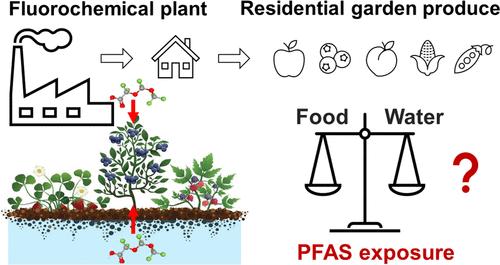Residential Garden Produce Harvested Near a Fluorochemical Manufacturer in North Carolina Can Be An Important Fluoroether Exposure Pathway
IF 5.7
1区 农林科学
Q1 AGRICULTURE, MULTIDISCIPLINARY
引用次数: 0
Abstract
Dietary intake can be an important exposure route to per- and polyfluoroalkyl substances (PFASs). Little is known about the bioaccumulation of emerging per- and polyfluoroalkyl ether acids (PFEAs) in garden produce from PFAS-impacted communities and the associated dietary exposure risk. In this study, 53 produce samples were collected from five residential gardens near a fluorochemical manufacturer. Summed PFAS concentrations ranged from 0.0026 to 38 ng/g wet weight of produce, and water-rich produce exhibited the highest PFAS levels. The PFAS signature was dominated by PFEAs, and hexafluoropropylene oxide-dimer acid (commonly known as GenX) was detected in 72% of samples. Based on average measured GenX concentrations, chronic-exposure daily limits were as low as 289 g produce/day for children (3–6 yr). This analysis does not consider other PFEAs that were present at higher concentrations, but for which reference doses were not available. This study revealed that consuming residential garden produce grown in PFAS-impacted communities can be an important exposure pathway.

在北卡罗来纳州一家氟化工生产厂附近收获的住宅花园农产品可能是重要的氟醚暴露途径
膳食摄入可能是接触全氟烷基和多氟烷基物质 (PFAS) 的一个重要途径。对于受全氟辛烷磺酸影响社区的花园农产品中新出现的全氟烷基和多氟烷基醚酸 (PFEA) 的生物累积情况以及相关的膳食暴露风险,人们知之甚少。在这项研究中,从一家氟化工生产商附近的五个住宅花园中收集了 53 份农产品样本。农产品中的全氟辛烷磺酸浓度总和从 0.0026 到 38 纳克/克湿重不等,富含水的农产品中全氟辛烷磺酸含量最高。PFAS 特征以 PFEAs 为主,72% 的样本中检测到六氟环氧丙烷二聚酸(俗称 GenX)。根据测得的 GenX 平均浓度,儿童(3-6 岁)的慢性暴露每日限值低至 289 克农产品/天。这项分析没有考虑浓度较高但没有参考剂量的其他全氟乙烷。这项研究表明,食用在受全氟辛烷磺酸影响的社区种植的住宅花园农产品可能是一个重要的暴露途径。
本文章由计算机程序翻译,如有差异,请以英文原文为准。
求助全文
约1分钟内获得全文
求助全文
来源期刊
CiteScore
9.90
自引率
8.20%
发文量
1375
审稿时长
2.3 months
期刊介绍:
The Journal of Agricultural and Food Chemistry publishes high-quality, cutting edge original research representing complete studies and research advances dealing with the chemistry and biochemistry of agriculture and food. The Journal also encourages papers with chemistry and/or biochemistry as a major component combined with biological/sensory/nutritional/toxicological evaluation related to agriculture and/or food.

 求助内容:
求助内容: 应助结果提醒方式:
应助结果提醒方式:


